Onions - an indispensable product, both in a daily diet and on a festive table. The grade of Luke Hercules attracts attention not only by its delicate taste, but also ease of cultivation. Troubleshide, drought-resistant and high-yielding grade of Luke won the love of many private traders and farms.
The result of Dutch breeders, the onions of Hercules are practically not amazed by pests and diseases, and is intended for long-term storage. At the same time, the bulbs fully retain all their useful properties and taste. How to grow the onions of Hercules on his site? How to achieve the highest crops and, what care to provide this vegetable culture? Details and step-by-step instructions in this article.
Bow Hercules, description of the variety
Consider the basic characteristics of the bow with an unusually beautiful and eloquent name - "Hercules".
- The onions of Hercules - a hybrid with the middle time of ripening. A full period of ripening of bulbs is about 80 days.
- The bulbous culture is considered a two-year-old plant, when seeds are first seeded, from which small bulbs are obtained - the north. On the 2nd year, the onions of the north are planted, from which major bulbs directly used in food are matured.
- In the height of the green stalks of the plant reach 30-35 cm. Considering the "hybrid" origin of vegetable culture, collecting the seeds of the Hercules of Hercules is not advisable, since they are not capable of playing.
- The onion of this variety has a well-developed root system, which allows to actively "produce" a plant moisture (even in dry periods) and nutritional elements. This valuable quality is very useful with a long lack of natural precipitation and in conditions involving not frequent watering. That is why the cultivation of this line of Luke is especially common in arid regions.
- The ridden bulb has a form slightly elongated oval and quite large parameters (hence the name of the variety). The middle weight of the bulbs is 130-150. The bulb is covered with dense skin and golden yellow scales. The flesh of juicy, white, without bitterness.
- The vegetable is widely used in food both in fresh form and in recycled. At the same time, thermal treatment in any way does not worsen the taste of the bow, but on the contrary, the spicy supplement makes the dish multifaceted and rich.
Bow Hercules, virtues of varieties
This hybrid Luca variety has a number of advantages that are appreciated not only by private daches or gardeners, but also large farms.
- The bow of this variety differs from its "relatives" saturated, soft, piquant - isolate, taste and characteristic of all representatives of the family, onion aroma.
- The onion of the grade Hercules is valued for the ability to long-term storage time, in which culture fully retains its taste and is practically not spoiled. This is explained by the fact that Dutch breeders specially worked on obtaining unpretentious and hardy culture with long-term "timing" storage.
- The onions of the Hercules (the result of Dutch selection) is highly resistant to a row of typical diseases of diseases and pests. In addition, vegetable culture is characterized by increased resistance to weather changes.
- This species of Luca became particularly popular due to the high level of obtained crops, when from Square in 1m 2 About 8 kg of valuable and useful product are collected. This indicator is at times exceeds the yield indicators of other varietal representatives of vegetable culture.
- The onions of Hercules grown "on the bulb" practically does not "go to the arrow", which has a positive effect on the yield and quality of the product during storage.
- The variety is characterized by increased cold resistance and is suitable for landings not only in spring time, but also for the winter. The vegetable is successfully cultivated both in the open soil and in greenhouse conditions.
- Useful and vitamined bow is an indispensable product for the human body.
Given this number of advantages and positive qualities, according to the reviews of many gardeners-Gardeners, "Hercules" is recognized as one of the best grades of Luke today. And although the cost of seeds can exceed the remaining Luke varieties, the result is worth it!
Onions Hercules, planting technology
To get a good harvest of high-quality product, it is important to comply with the main agrotechnical rules for planting the plant. And although, the bow is considered a little whimsical culture, it is important to prepare the site in advance and choose the best time to land the representatives of the Lukovy family.
The onions of Hercules can be raised by 2 ways that differ in the process.
- Sowing seeds, "giving" in the 1st year of the onion of the north, which the next year is planted again in the ground and only on the 2nd year they receive a large onion of Hercules.
- Landing through a small onion-sevka, when the crop of rusty bulbs already collect the landing.
Thus, the bow-north for planting can be purchased in specialized stores or grow independently, from seeds.
Luke Luca Time Hercules
- Most often, the onions of Hercules land in the open soil in the spring (in April-May), when the temperature of the air stabilizes at a not lower than +10 0C, and the soil retains the elevated moisture level. A more specific time of landing of Luke Hercules depends on the climatic conditions of this or that region.
- The thermal-loving grade of Hercules negatively "reacts" to land in the cold ground, which can provoke a bumping of a plant bulwish. Therefore, you should not hurry with a very early landing of Luke.
- Looking is also possible by sedate, which will ensure earlier harvest. For this, the early spring bow of the north is planted into containers, and after its germination and establishing steadily warm weather, transplanted into open ground.
- The autumn landing of the bulbies (the smallest specimens of Sevka) is practiced, under the winter (2-3 weeks before the alleged first frosts). In the regions with a cold climate, the attachments are additionally covered with foliage or sawdust. Winter landings do not "give" fractures and provide for a long time of crop storage.
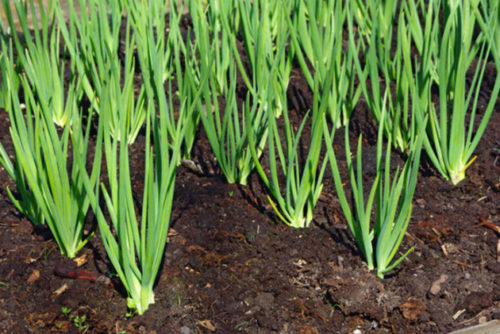
Luke Place Hercules
- For landing, you choose a smooth solar section, without shading by trees or houses. Miln or too shaded terrain for landing onion is not suitable.
- If the area area allows, it is best to change the place for planting vegetable crops every year, including onion. This technique will help prevent the appearance of pests and diseases typical.
- The best predecessors of the onions are attached to planting potatoes, cucumbers, cabbage, tomatoes or representatives of the legume family.
- The clay, overwhelmed or marshy soil is not suitable for landing.
- As for the level of acidity, the onions prefer a weakly acidic or neutral soil reaction. Sour soils are less preferable for growing onions.
- First of all, the landing site should be switched, to dissolve and remove all the weed grass. These preparatory activities are carried out approximately 5-7 days before Luke landing.
- Fertilizers most often contribute to the soil in the fall so that they overwhelm in the winter and turned into a homogeneous mass. If the earth did not work in the fall, the fertilizers make in spring, during the preparation of the site. The quantity and quality of fertilizer injected depend on the composition and fertility of the soil. For Suglinkov, humid, superphosphate, urea and peat are made. For sandy soil, a mixture of peat, humidiation, clay soil, urea and superphosphate will fit.
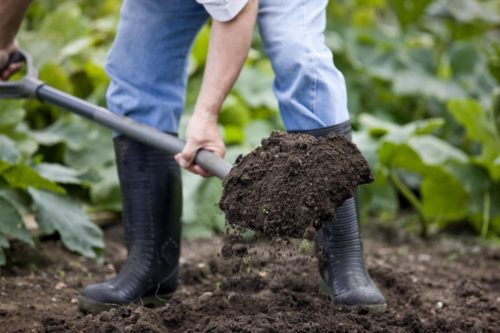
Sowing Luca Seed Hercules
- Buying the seeds of Luke Hercules, it is important to pay attention to the shelf life of the sowing material. From this directly depends on the percentage of seeds, which, every year, decreases by 30%.
- As a rule, seeds purchased in specialized stores are sorted and processed, and do not need any additional manipulations.
- Improve the germination of seeds will help the epin growth biostimulator, which is added to the water when landing or soaking seeds.
- Sowing Luca Seed Hercules is carried out in separate containers with soil intended for vegetable crops. You can also prepare the ground yourself, mixing the equal parts of the garden land and humus, and adding 1 cup of wood ash into this mixture.
- It is possible to sow bow seeds into a closed ground in March.
- For sowing, there are shallow grooves on the surface of the soil (between them) in 3-4 cm. The grooves are moisturized with water and one by one lay out seeds, retreating 1-1.5 cm from each other. The sinking seeds are sprinkled with soil mixture and moisturized from a finely dispersed pulverizer.
- To speed up the process of germination of seeds, the container is covered with glass or film, after which the "mini-greenhouse" is placed in a warm place (with a temperature of at least +20 0C) with scattered lighting.
- After the first shoots appear, the container is transferred to a well-lit place with a slightly lowered (up to +17 0C) temperature.
- The main conditions for the care of seedlings: moderate soil moisturizing (as drying), lighting at least 10-12 hours per day, feeding with potash-phosphoric fertilizers.
- On the eve of the planning of seedlings in the open ground (usually in May month), the onions begin to order. First, the container with the seedle is put on the street (balcony, veranda) for 1-1.5 hours, gradually increasing this time to day.
- Before planting, the green part and the roots of the bow at 1 \\ 3 of their lengths are cut. Seed out in advance prepared and moisturized grooves, in non-fit weather, better in the evening.
Agrotechnology landing onion Sevka Hercules
- For the landing of Hercules, as a rule, the so-called is used. Onions - sevock, the dimensions of which do not exceed 2-3 cm. You can grow in advance such planting bulbs from seeds. Too big or small bulbs for landing are not suitable.
- It is not suitable for landing also fiddled, torn, sluggish or dried (hollow) bulbs. Therefore, the first stage of the preparation of Luke to landing will be sorting.
- Immediately before landing, the onions dried in a warm room for 2-3 days. It is recommended to lay onions under the window so that the sunlight falls on it.
- Some gardeners handle Luke planting material in nitroposka. Such a prophylactic measure contributes to the prevention of the occurrence of a number of diseases. For this, 1 tbsp. Nitroposki is dissolved in 10 liters of water, after which the bulbs prepared for landing are placed in a solution for 15-30 minutes. After the procedure, the dried bulbs can be additionally treated with a copper sulfate solution.
- The bulbs planted into the ground, in the grooves, observing the interval between the instances of about 10 cm. The distance in the aisle must be 2 times more (about 20 cm). Such a landing scheme will ensure the maximum plant development and will allow to get the greatest harvest.
- The sealing depth of Luke-Spark in the ground is about 3-5 cm (so that it was about 2 cm of soil over the "tail"). Watering the groove after landing is not necessarily, since natural moisture in the spring is still enough to germinate the plant, and the excess moisture is not desirable for Hercules.
Loom Care Hercules
This vegetable culture is absolutely unpretentious in care and practically does not require attention from the garden. It will take only standard procedures: weeding, watering, loosening.
Watering and loying onion Hercules
- The Dutch grade of Luke "Hercules" is a sufficiently drought-resistant variety and does not "like" excessive humidity provoking rotting and developing various diseases of the bulbs.
- Watering a bed with a bow should be in a dry period when there is a lack of natural precipitation. At the same time, watering is especially important in the first phase of the development of Luke, when the stems are green, and the bulb grows.
- As the bulb increases, the watering is gradually reduced, and when the stems (2-3 weeks before harvesting) are completely stopped. In no case cannot allow moisture stagnation on a garden with a bow.
- After irrigated (or rain), the bed with a bow should be exploded so as not to form a solid crust that prevents the air permeability of the soil.
- According to experienced gardens, regular soil loosening not only contributes to better development of bulbs, but also reduces the bitter taste of their pulp.
- Sugging a bed with a bow, we should remove weeds from the site to protect the bulbous culture from infecting diseases.
- Immediately after landing, the garden is better to climb sawdust or straw. Mulching prevents the development of weed grass, keeping the wet soil microclimate.
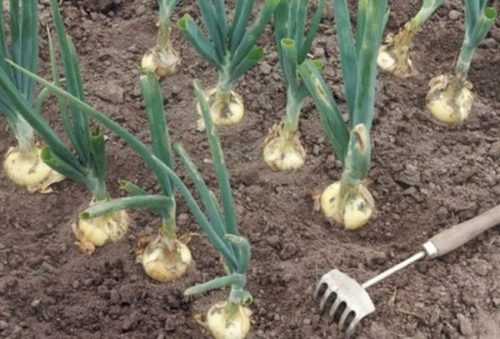
Putting fertilizers and feeding Luca Hercules
- Additional subcortex of the bow, especially with scarce in the composition of soils, positively affects the yields of culture.
- The first time to feed the landing of a bow can be nitrogen-containing fertilizers in 2 weeks after landing. The following feeder is carried out after another 2 weeks with complex mineral fertilizers. The last, third, feeding is also carried out in 2 weeks with potash fertilizers.
- Abused nitrogen fertilizers, especially in the second half of the growing season, it is impossible, as it will negatively affect the aging of the bulbs.
- Yellowed (not for season) The feathers of Luca often testifies to the lack of nutrients. In this case, the bow needs an emergency feeding. To do this, you can use a solution of chicken litter and urea (on 10 liters of water 1 cup of litter and 1 tbsp. Urea). 2 weeks after such feeding, the garden is shed a nitroposk solution. These procedures contribute to the improvement of the plant, the normalization of its development and the disappearance of the yellow painting of feathers.
Fighting diseases and pests of Luca Hercules
- The onions of Hercules was originally removed by breeders as resistant to diseases and pests, onion variety. Therefore, typical of representatives of onion diseases (peronosporosis, rot cervical, Lukovaya Fly, etc.) is practically not amazed.
- As prophylactic insect insect insects, it is possible to apply landing near the bed with a bow of fragrant velvetsev, wormwood or pizzy.
Collection and storage of Luke Hercules
- Ripening onions occurs at the end of the summer - the beginning of autumn, depending on the region and landing time. Harvesting should be carried out in dry weather. The main criterion for the aging of the bulbs - the films and yellowed feathers of Luke.
- Before you begin harvesting, it is recommended to first challenge the fading feathers of the onions and burn them to the ground. This technique allows you to significantly speed up the process of aging bulbs.
- After the harvest was assembled, it is important to properly prepare the bulbs to winter storage. For this, the bulbs shake off the ground and dried first on the garden (in 1 layer), and then on the street, under a canopy (within 1-2 days). In this case, dry tops are not immediately cut off to enable valuable trace elements to move from feathers to the bulbs, thereby improving not only its quality composition and nutritional value, but also taste.
- Dried onions fold for storage in dry cool (ventilated) place. The optimal temperature for storing bulbs is from +15 to +20 degrees. In the conditions of high humidity, the bow can start refusing, and in too hot room - to dry.
- Luke storage packaging should be well ventilated, wooden or plastic boxes, mesh, etc. are suitable. Boxes are installed on any support (for air circulation), and the grids are suspended.
- Observing all the above designated storage conditions, the crop will be kept all winter, until spring, without losing taste and nutritional value.
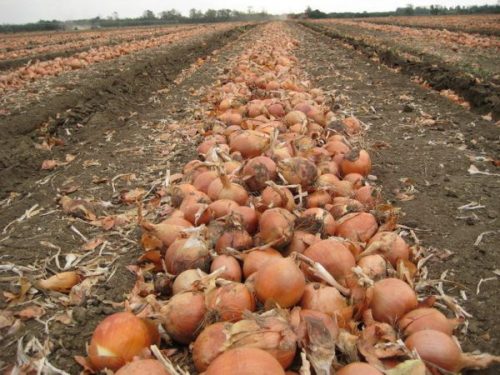
The use of Luka Hercules
- The onions of Hercules, like most other representatives of this species, has long been recognized as valuable and useful for human health, product.
- Onions contain vitamins B, RR, C, N, E, proteins, mineral salts, sugar, microelements (copper, iron, iodine, bromine, cobalt, manganese, chrome, fluorine) and macroelements (potassium, calcium, sulfur, magnesium, sodium , chlorine, phosphorus).
- Onions are considered a low-calorie product that contributes to weight loss. In addition, the individual components of the onions stimulate the generation of insulin, contributing, thereby decreasing blood sugar levels.
- Natural antibacterial agent, fresh onions, causes the death of many pathogenic microbes and bacteria. In this regard, its eating is shown in ORVI diseases, flu. Luca compresses are also used to treat many skin diseases.
- Substances containing in the pulp of bulbs have long established themselves as a valuable remedy for strengthening hair, nails, the prevention of dandruff.
Thus, the onions of Hercules are one of the best grades of Luca today. Unpretentious, high-yielding, resistant to diseases and pests, tasty and remaining for a long time - these are the main advantages of this valuable product. The onions of Hercules are recommended for cultivation, both experienced gardeners and novice gardens lovers.

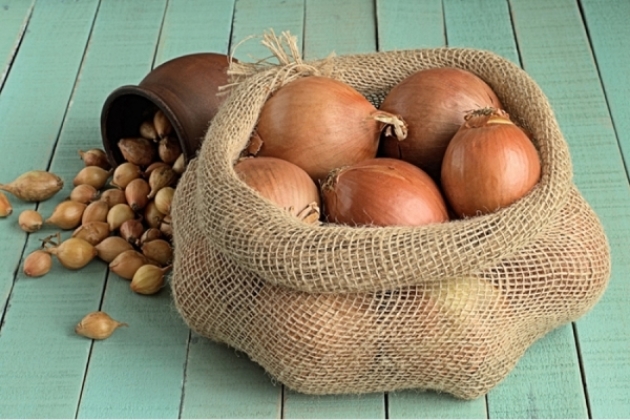
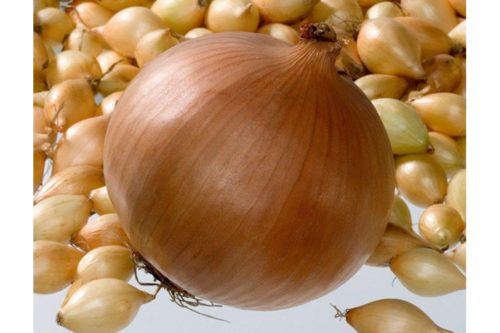
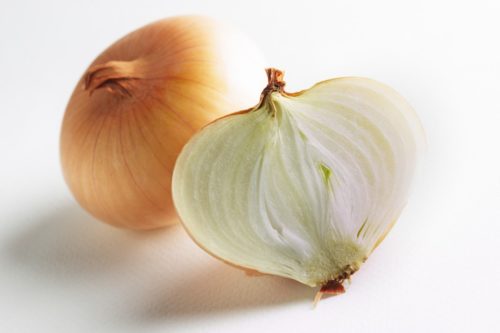
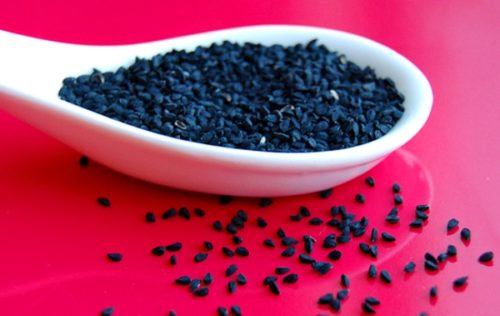
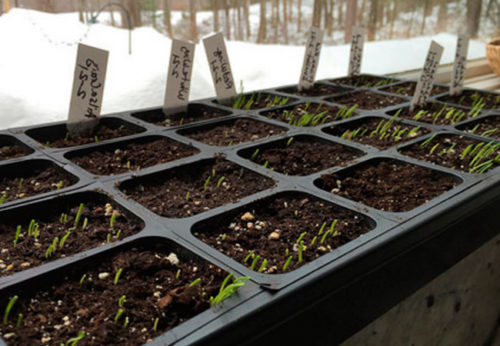
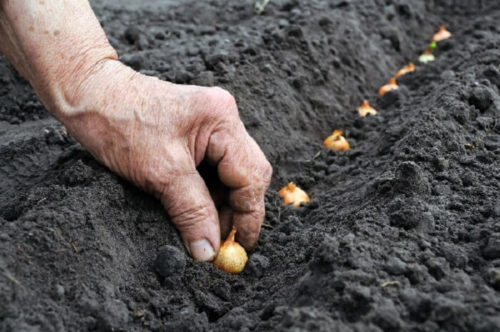
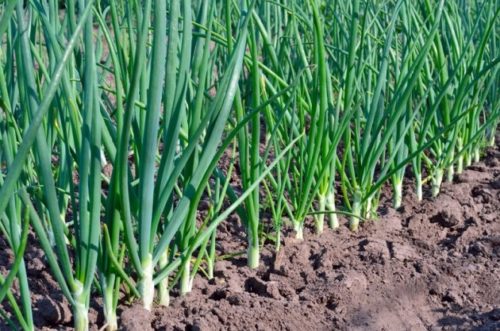
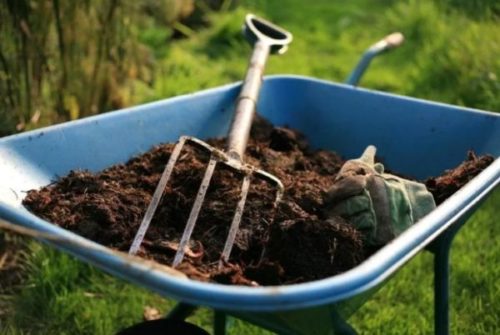
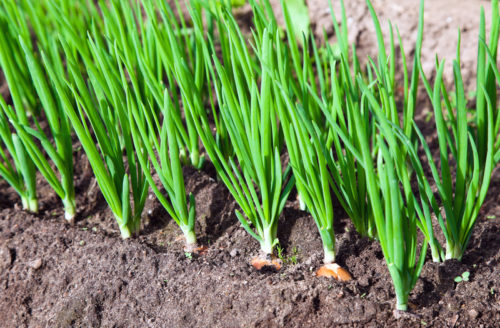
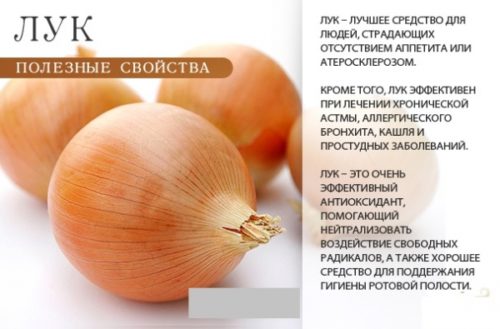
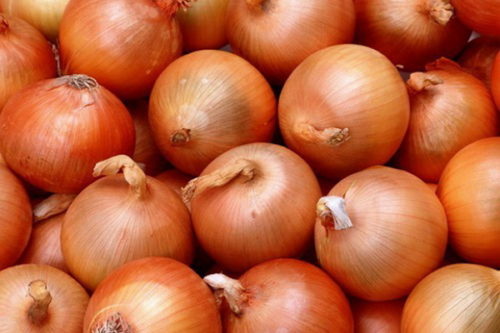












 Start a discussion ...
Start a discussion ...